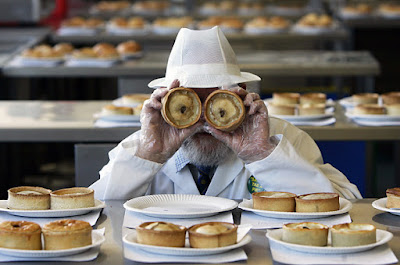Final Exam Review
Johnson Smith, an adroit baker, posing with two beautiful scottish pies. He had just won the pastry baking contest in Edinburgh.
A marathon runner, Charles Martin, kisses the ground passionately. He had just finished his 500 meter sprint.
1. Rule of thirds: the subject isn't necessarily centered, but it's one third of the picture. (think of splitting your picture into thirds vertically and horizontally
2. Balancing Elements: all images have an equal visual weight
3. Leading Lines: the viewer can be easily attracted to lines leading to the main subject of the picture
4. Symmetry and Patterns (repetition): repetiton of patterns or an object in a picture, creates rhythm and unifies the work as a whole
5. Viewpoint: angle or direction from where you choose to take the picture
6. Background: the stuff behind the subject (make
7. Create depth: including of objects in the foreground, middleground, and background
8. Framing: placing all of the extra objects that make the photo look nice and help to isolate the main subject from everything else
9. Cropping: getting rid of all the background "noise" to focus on the main thing
10. Mergers and avoiding them: looking for plain backgrounds so other objects don't merge with the main subject
3. aperture: either adds dimension by blurring the background and focusing on the subject, or focuses every single thing. A larger aperture allows more light to travel while a smaller allows less.
shutterspeed: It either freezes action or blurs motion. Also means the length of time a camera shutter is open to expose light in the camera. Fast shutterspeed freezes and slow makes it blurry.
ISO: level of sensitivity of the camera to light. The lower the ISO, the less sensitive. Higher sensitivy can be used to take pictures in low-light places, but it does add grain.
4. It isn't ethical to completely change a persons face. Changing the lighting or adding cool effects is okay, but nothing shoud be drastically changed in the subjects apperance.
5. enivronmental: taken in the person's usual environment, doing their usual thing (showing their hobbies, activities, etc)
self:a picture of ones self.
casual: an informal picture of someone
6. Exposure: the amount of light per unit of area
Depth of Field: distance between the farthest and closest objects in a scene that show up in the picture
Focal Length: distance between the lens and the image sensor when the subject is in focus
Early: It looks like a book cover with a table of contents, title, and publication date.
Poster: no cover lines or themes announced, just a main picture with a few words. (looks like a poster)
Married to Type: typically had a large title with a person's face.
Forest of Words: filled with cover lines, the words distract the picture.




Comments
Post a Comment